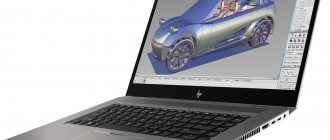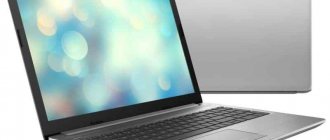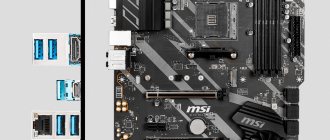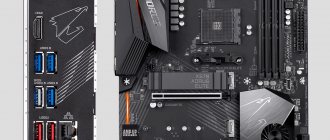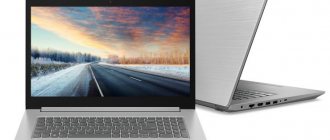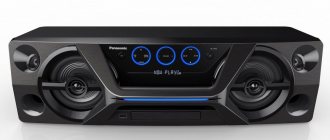Rating of the TOP 12 best ASUS laptops
| Place | Model | Price |
| The best models in terms of price and quality ratio | ||
| #1 | ASUS M509 | |
| #2 | ASUS VivoBook 15 X512 | |
| #3 | ASUS M570 | |
| #4 | ASUS Laptop 15 X509 | |
| The best gaming models | ||
| #1 | ASUS TUF Gaming FX505 | |
| #2 | ASUS ROG Zephyrus G GA502 | |
| #3 | ASUS TUF Gaming FX705 | |
| #4 | ASUS ROG Zephyrus M GU502 | |
| The best ASUS ultrabooks and convertibles | ||
| #1 | ASUS VivoBook Flip 14 TP412 | |
| #2 | ASUS ZenBook Flip S UX370 | |
| #3 | ASUS ZenBook Flip 14 UX463FA-AI043T | |
| #4 | ASUS ZenBook 14 UM431 | |
Page navigation:
Which laptop is better - Asus or Lenovo?
If you compare the technical parameters and purpose of equipment from these manufacturers, it becomes clear that their products can significantly compete for the position of leader in the market.
Both brands offer different solutions for everyday tasks, games, and entertainment.
But Lenovo's build quality is more lame: there are often problems with the case and video card. Asus's weak point is the quality of its budget models. Therefore, experts recommend choosing more expensive options.
What's good about ASUS laptops?
The laptops produced by the company are characterized by an excellent combination of price and quality.
Note! The company has launched many models on the market that are suitable for solving various practical problems.
Their key features :
- reliability in operation;
- high technical parameters;
- functionality;
- stylish design.
ASUS laptops offer a full range from inexpensive models with small and medium performance to powerful gaming platforms.
How to choose a reliable Asus laptop?
To make the right choice, experts in 2021 recommend paying attention to the following parameters.
- Screen size . 15-inch laptops have become the most popular. They are found in groups with budget and most expensive equipment.
- Memory . To solve simple problems, 500 GB will be sufficient. For RAM, you should choose DDR3 or DDR4, since these are modern options. To work with office programs and surf the Internet, 4 GB is enough, for games - from 16 GB.
- Screen resolution . Good performance is considered to be 1366x768 pixels. More expensive models have a screen resolution of 2048x1080.
- Processor . Intel Core 7 and higher generations are often found in Asus laptops. The older the version, the faster the model.
- Battery options . The models mainly use lithium-ion batteries. It’s good if the battery lasts for 6 hours or more without connecting to a charger.
The best models in terms of price and quality ratio
ASUS offers many simple, versatile, inexpensive models. They are mainly aimed at the corporate market.
Nevertheless, such laptops are suitable for both study and entertainment.
Rating of the TOP 5 best Asus models in terms of price and quality.
ASUS M509
The M509 model is equipped with an up-to-date operating system, modern hardware and a set of the most popular options with support for most modern peripheral devices.
The laptop is capable of performing all basic tasks for home or office use.
The laptop has a high-quality display with an energy-efficient and fast matrix, a central processor from AMD, and a powerful video card.
High-speed RAM up to 8 GB, a capacious hard drive and a capacious battery further expand the capabilities of the device, from using office programs and Internet surfing to working with videos and not too demanding games.
Specifications:
- OS - Endless, Windows 10;
- processor - Ryzen 3/5;
- RAM - 4-8 GB;
- screen diagonal 15.6″, resolution – 1920×1080;
- matrix type - IPS, TN;
- video card - AMD Radeon Graphics/Vega 3/8, NVIDIA GeForce MX230;
- hard drive - HDD+SSD, SSD with a total capacity of 128-1256 GB;
- support microSD, microSDHC, microSDXC;
- wireless technologies - Wi-Fi, Bluetooth 4.1/4.2;
- interfaces - USB, HDMI, audio;
- battery capacity - 4050-4212 mAh;
- operating time - 4-5 hours;
- webcam 0.3 MP;
- weight - 1.69-1.9 kg.
Advantages
- convenient touchpad that recognizes gestures;
- quiet, efficient cooling system;
- high overall performance;
- affordable price.
Flaws
- unnatural colors (can be adjusted manually);
- no port for wired internet;
- low camera resolution.
ASUS VivoBook 15 X512
It stands out for its spectacular frameless screen design, constructed using innovative NanoEdge technology.
The frame thickness in this model is 5.6 mm, the relative screen area reaches 88%.
The ASUS VivoBook 15 X512 keyboard easily rotates at any angle, thanks to special screen hinges.
The VivoBook 15 X512 laptop computer is equipped with a powerful central processor from Intel or AMD, depending on the configuration, a powerful graphics subsystem and enough RAM to perform various tasks.
Specifications:
- OS - Endless, Linux, Windows 10;
- processor - Core i3/i5/i7, Ryzen 3/5/7;
- RAM - 4-12 GB;
- screen diagonal 15.6″, resolution – 1366×768, 1920×1080;
- matrix type - IPS, TN;
- video card - AMD Radeon 540X/RX Vega 10/Vega 10/3/8, Intel HD Graphics 620/UHD Graphics 620, NVIDIA GeForce MX110/MX130/MX230/MX250/MX330;
- hard drive - HDD, HDD+Optane, HDD+SSD, SSD with a total capacity of 128-1256 GB;
- support microSD, microSDHC, microSDXC;
- wireless technologies - Wi-Fi, Bluetooth 4.0/4.1/4.2;
- interfaces - USB, HDMI, audio;
- battery capacity - 3650-4050 mAh;
- operating time - 5 hours;
- webcam 0.9-1 MP;
- weight - 1.6-1.95 kg.
Advantages
- matte anti-glare screen;
- there is a keyboard backlight;
- good performance for light tasks;
- silent operation.
Flaws
- not the best autonomy;
- low sound quality of built-in speakers;
- no Ethernet port.
ASUS M570
The X570 looks tiny compared to bulky gaming laptops.
But with its help you can not only type text or watch videos, but also launch modern games.
The device boasts modest dimensions - its thickness when folded is 21.9 mm.
Despite its compact size, the device confidently handles programs and games, using the GTX 1050 video card to its full potential.
The graphics module is supported by a modern processor and 8 gigabytes of RAM.
Specifications:
- OS - Windows 10;
- processor - Ryzen 5/7;
- RAM - 8 GB;
- screen diagonal 15.6″, resolution – 1920×1080;
- matrix type - IPS, TN;
- video card - NVIDIA GeForce GTX 1050;
- hard drive - HDD+SSD, SSD with a total capacity of 256-1256 GB;
- support microSD, microSDHC, microSDXC;
- wireless technologies - Wi-Fi, Bluetooth 4.0/4.1/4.2;
- interfaces - Ethernet, USB, HDMI, audio;
- battery capacity - 4110-4200 mAh;
- operating time - 9 hours;
- webcam 0.3 MP;
- weight - 1.9 kg.
Advantages
- stylish design;
- excellent performance;
- easy-to-use keyboard;
- quick system startup;
- loud speakers.
Flaws
- no keyboard backlight;
- no Num/Caps lock indication;
- slight screen glare;
- BIOS is not customizable.
ASUS Laptop 15 X509
Linen design and advanced technology and can be used for work, study and entertainment with equal success.
The ASUS Laptop 15 X509 laptop is equipped with a modern, productive, energy-efficient hardware system.
The display is made using NanoEdge technology. The thin-frame screen is complemented by a matte anti-glare coating.
The compact device is equipped with ports for connecting peripheral equipment, and there are built-in modules for wireless communication.
Optical wireless mouse included.
Specifications:
- OS - Endless, Linux, Windows 10;
- processor - Celeron, Core i3/i5/i7, Pentium, Ryzen 3;
- RAM - 4-8 GB;
- screen diagonal 15.6″, resolution – 1366×768, 1920×1080;
- matrix type - IPS, TN;
- video card - Intel HD Graphics 520/610/620/UHD Graphics/UHD Graphics 600/610/620, NVIDIA GeForce MX110/MX230/MX250/MX330;
- hard drive - HDD, HDD+SSD, SSD with a total capacity of 128-1256 GB;
- support SD, SDHC, SDXC, microSD, microSDHC, microSDXC;
- wireless technologies - Wi-Fi, Bluetooth 4.0/4.1/4.2;
- interfaces - USB, HDMI, audio;
- battery capacity - 3650-4212 mAh;
- operating time - 5-6 hours;
- webcam 0.3-1 MP;
- weight - 1.8-1.9 kg.
Advantages
- wide viewing angles of the screen without distortion;
- excellent color rendition;
- compact charger;
- there is a keyboard backlight;
- convenient touchpad.
Flaws
- Endless OS is not for the faint of heart;
- The battery discharges quickly.
The best gaming models
ASUS gaming laptops cannot be called ultra-thin and weightless . But they have improved performance characteristics.
For your information! The company's designers also pay attention to the appearance of the devices; many gaming models are unique in this regard.
ASUS TUF Gaming FX505
The gaming model TUF Gaming FX505 belongs to the line of exclusive laptops with a powerful graphics card and excellent technical characteristics.
It can be successfully used to run medium and heavy applications.
A high level of performance is supported by a multi-core central processor and a powerful video module.
Large amounts of RAM and a fast hard drive increase data processing speed. Built-in DTS Headphone:X adds realism to your gaming experience.
Specifications:
- OS - Windows 10;
- processor - Core i5/i7, Ryzen 5/7;
- RAM - 6-16 GB;
- screen diagonal 15.6″, resolution – 1920×1080;
- matrix type - IPS;
- video card - AMD Radeon RX 560X, NVIDIA GeForce GTX 1050/1050 Ti/1060/1650/1660 Ti/RTX 2060;
- hard drive - HDD, HDD+SSD, SSD with a total capacity of 256-1512 GB;
- wireless technologies - Wi-Fi, Bluetooth 4.0/4.2/5.0;
- interfaces - Ethernet, USB, HDMI, audio;
- battery capacity - 2526-4240 mAh;
- operating time - 3-5 hours;
- webcam 0.92-1 MP;
- weight - 2.2-2.3 kg.
Advantages
- reliable and durable body;
- thoughtful arrangement of input elements and connection ports;
- modern hardware;
- a lot of RAM.
Flaws
- the touchpad may become glitchy when connecting a mouse;
- short battery life;
- heavy weight.
ASUS ROG Zephyrus G GA502
Equipped with an ultra-thin body and powerful hardware, it can handle even demanding games.
Inside the device there is a current processor from AMD, an NVIDIA gaming video card and up to 32 GB of RAM.
At the same time, the ASUS ROG Zephyrus G GA502 laptop weighs just over 2 kg, and the thickness of its case is only 2 cm.
The device is equipped with a high-quality audio system with two speakers and an intelligent Smart-AMP amplifier with increased dynamic range and minimal distortion even at maximum volume.
The keyboard is complemented by a number of keys for controlling multimedia functions and quick launch.
Specifications:
- OS - Windows 10;
- processor - Ryzen 7;
- RAM - 8-32 GB;
- screen diagonal 15.6″, resolution – 1920×1080;
- matrix type - IPS;
- video card - NVIDIA GeForce GTX 1660 Ti/1660 Ti MAX-Q/RTX 2060 Max-Q;
- hard drive - SSD with a capacity of 512-1024 GB;
- wireless technologies - Wi-Fi, Bluetooth 5.0;
- interfaces - Ethernet, USB, HDMI, audio, DisplayPort;
- battery capacity - 4800 mAh;
- operating time - 5.5 hours;
- webcam optional;
- weight - 2.1-2.2 kg.
Advantages
- the display conveys the image perfectly;
- reliable keyboard with three levels of white backlight;
- topical iron;
- modern ports for connecting peripherals;
- the processor is not subject to throttling even at maximum load;
- There is a self-cleaning system for coolers.
Flaws
- low maximum screen brightness;
- no card reader and camera;
- The hot air outlet is organized on the right (on the hand with the mouse for right-handed people).
ASUS TUF Gaming FX705
It will allow you to play popular shooters or strategies without any problems; it will not shrink when you see the system requirements of modern games.
The ASUS TUF Gaming FX705 laptop uses a gaming graphics card, the capabilities of which are enough to comfortably play most games.
The huge 17.3-inch display with a bright, color-saturated picture supports Full HD resolution and has all the advantages of an IPS matrix.
The HyperStrike keyboard features WASD shortcut keys, isolated arrow keys, wide space bar, and fast key technology.
Specifications:
- OS - Windows 10;
- processor - Core i5/i7, Ryzen 5/7;
- RAM - 6-16 GB;
- screen diagonal 17.3″, resolution – 1920×1080;
- matrix type - IPS;
- video card - AMD Radeon RX 560X, NVIDIA GeForce GTX 1050/1050 Ti/GTX 1060/1650/1660 Ti;
- hard drive - HDD, HDD+SSD, SSD with a total capacity of 256-1512 GB;
- wireless technologies - Wi-Fi, Bluetooth 4.2/5.0;
- interfaces - Ethernet, USB, HDMI, audio, micro HDMI;
- battery capacity - 4140-4240 mAh;
- operating time - 3-5 hours;
- webcam 0.92-1 MP;
- weight - 2.54-2.8 kg.
Advantages
- powerful filling;
- stylish design;
- 16 GB of RAM in the maximum configuration;
- soft pressing with instant key response;
- efficient cooling system.
Flaws
- there are small screen highlights on a black background;
- due to the powerful cooling system it is very noisy;
- Windows 7 cannot be installed.
ASUS ROG Zephyrus M GU502
It is a portable gaming platform with modern hardware in a durable aluminum-magnesium alloy case.
The IPS screen of the ROG Zephyrus M GU502 model boasts remarkable parameters - a luxurious refresh rate of 240 Hz and a meager response time of 3 ms.
Due to this, the display smoothly reproduces the fastest movements. A digital audio amplifier and loud front-facing speakers complement your video content with impressive surround sound.
The laptop's powerful hardware required an equally powerful cooling system - two fans and five heat pipes.
The built-in Armory Crate program allows you to optimize device performance, adjust fan speed, and create custom settings profiles for games.
Specifications:
- OS - Windows 10;
- processor - Core i7;
- RAM - 16-32 GB;
- screen diagonal 15.6″, resolution – 1920×1080;
- matrix type - IPS;
- video card - NVIDIA GeForce GTX 1660 Ti/RTX 2060/2070/2070 Max-Q;
- hard drive - SSD with a capacity of 512-1024 GB;
- wireless technologies - Wi-Fi, Bluetooth 5.0;
- interfaces - Ethernet, USB, HDMI, audio, DisplayPort;
- battery capacity - 5000 mAh;
- operating time - 3.5-5.5 hours;
- 1 MP webcam;
- weight - 1.93 kg.
Advantages
- light weight;
- durable body that is pleasant to the touch;
- The lid can be opened with one hand;
- acceptable autonomy taking into account battery capacity and hardware power;
- powerful power supply.
Flaws
- not suitable for installing Linux systems;
- too bright unregulated indicators on the front panel of the case;
- easily soiled top panel of the case.
ASUS gaming laptops: past and present of the ROG series
The history of the ASUS gaming laptop series began with the appearance of two models: the fifteen-inch G1P and the seventeen-inch G2P. In those days, ASUS series indexes were not strictly tied to the screen diagonal, so the ones and twos in the names “fifteen” and “semnashki” did not confuse anyone, although, presumably, they confused many buyers.
ASUS G1P - the first gaming tag of ASUS
Initially, the idea was quite unusual. The fifteen-inch G1P model was offered exclusively with NVIDIA graphics (GeForce Go 7700), and this laptop was finished in NVIDIA's signature bright lime color. In the G2P “semnashka”, on the contrary, only ATI graphics (Mobility Radeon X1700) were installed, and it was decorated, as you might guess, with red inserts.
Simultaneously with the “tag”, a gaming “tag” appeared - ASUS G2P
As a basis, both models used the updated Intel Centrino Duo (Napa) platform, which at that time included the first generation of Core 2 processors and 945 series chipsets. For the G2P model, a TV tuner was offered as an option: either analog (in this case, the laptop was named G2Pb), or hybrid - supporting both analog and digital signals (G2Pc). Only one hard drive was installed in both the “tag” and the “seven”.
The G1P cover was finished in carbon fiber
Among the interesting features, it should be noted that both models have decorative lighting, color-coded WASD keys and a small auxiliary display. As for materials, the first G-series laptops widely used metal and carbon fiber inserts, and in the “tag” the emphasis was placed more on “carbon”, and in the “seven” – on rough-polished aluminum.
In the G2P model, the cover surface was metal
Another feature of the first ASUS G-series laptops was the packaging: while other ASUS laptops at that time were equipped with classic briefcase bags, the boxes with the G1P and G2P included chic backpacks designed in the ROG style. In addition, both laptops were equipped with one of the best gaming mice of that time - Logitech MX518.
ROG series laptops came with an excellent mouse and a comfortable backpack
In the case of G2P, the presence of a complete backpack was especially important: a large 17-inch laptop did not fit into every bag
Both models were subsequently “reissued” several times. However, ASUS decided to move away from the clear division into “ATI’s product” and “NVIDIA’s product.” Although the colors in the decorative trim remained the same, the new models - G1S and G2S - used the same components: Intel Santa Rosa (965 series chipset) and NVIDIA GeForce 8600M GT graphics.
Also in 2007, the G2K model was introduced - a version of the gaming “semnashka” on the AMD platform. It used dual-core Turion X2 processors and an ATI Mobility Radeon HD 2600 graphics adapter. This laptop remained the only representative of the G-series on the AMD platform. After that, ATI graphics solutions were not used in ROG laptops for three whole years - until 2010.
The ASUS G2S, G2Sg, G2Sv and G2K models differed from the original G2P only in the hardware - the design remained unchanged
Another update to the gaming “seven” – G2Sg. As a result of the upgrade, the laptop received new NVIDIA 8700M GT graphics, and a new generation of Core 2 Duo on the Penryn core was added to the selection of home-made processors. In the next iteration, the “tag” received the same Penryn processors and GeForce 9500M GS graphics, and the 17-inch laptop was equipped with a GeForce 9650M GT adapter. The resulting models were G1Sn and G2Sv, respectively.
In parallel with the modernization of the G2, ASUS was working on creating a more powerful 17-inch gaming laptop. Introduced around the same time as the G2S, the G70S was a significant departure from its predecessors. This laptop was created under the slogan “Dual-Engine”: dual graphics system (two GeForce 8700M GT adapters operating in SLI mode), dual disk system (7200 rpm disks were also available), dual cooling system.
ASUS G70S is still the most impressive laptop in the series
The exterior has also been thoroughly redesigned. The lid and some of the G70's body elements were made of shiny aluminum. So, overall, the laptop resembled either a space marine or, conversely, a medieval knight.
The G70S model used two video adapters operating in SLI mode
After the update, this model received one of the most powerful mobile graphics adapters for its time - NVIDIA GeForce 9800M GTS. True, only one. Either the shortage of boards affected it, or the engineers were unable to modify the power and cooling systems to use the “double-barrel” SLI configuration, but such a version never appeared.
By this time, the economic crisis began to make itself felt. So the G70 model remained the most impressive of the ASUS gaming laptops, and later G-series laptops received a more modest exterior and somewhat less serious hardware. For example, the next generation of ASUS gaming laptops, the G71V, initially received only one video adapter. And not a top-end, but an average one - the GeForce 9700M GT, equipped with only 32 stream processors versus 64 for the 9800M GTS.
In the ASUS G71V model, the filling has become a little simpler, and the appearance has become more modest
But the platform has changed to a more recent one - Intel Montevina. Which meant the use of a new generation of Intel PM45 chipsets and an expanded range of Penryn-based Core 2 Duo processors, including the quad-core Core 2 Extreme QX9300. Like the previous model in the series, the G71V was equipped with two hard drives. It should be noted that support for dual-disk configurations has since become present in all ROG portable computers
Chic metal “armor” was replaced by ordinary glossy plastic
The new “tag” G50V was very similar to the G71V in appearance, and the filling was completely identical: the same platform, the same graphics, the same two hard drives. The only difference is that quad-core processors were not offered for the more compact G-series laptop.
The “Fifteen” G50V was designed in the same style as the “Fifteen” G71
After some time, a more powerful version of this model appeared - G50Vt. The main characteristics remain the same, but the graphics adapter has been seriously improved. Instead of the weak 9700M GT (32 stream processors), the laptop received a more befitting 9800M GS (64 stream processors) for a gaming machine. In addition, with the help of not too complicated changes in decorative trim, the designers were able to achieve a more impressive appearance of the updated laptop.
The updated model, ASUS G50Vt, has become noticeably more impressive: the body has been repainted silver, and a pattern has been added to the lid
The evolution of the “semnashki” at that moment was more interesting. ASUS relied on quad-core processors. But since mobile Core 2 Extreme QX9300 at that moment were incredibly expensive - more than $1000! – then they were replaced by more budget Core 2 Quad Q9000. The three times lower price of the processor more than compensated for the loss of 533 MHz clock frequency.
The list of improvements of the G71G compared to the G71V is not limited to this. In order to be able to use faster DDR3-1333 memory, the new product used the “desktop” Intel P43 chipset (for mobile chipsets of that time, DDR3-1066 was the ceiling). In addition, this made it possible to increase the maximum possible amount of memory: while mobile chipsets supported only two RAM modules, the P43 allowed the use of three. And, of course, the most important thing: the updated model received a GeForce 9800M GS graphics adapter - a small step back compared to the 9800M GTS used in the G70Sg, but still much better than the 9700M GT.
The Semnashkas did not change their appearance, but the filling was modernized: the G71G and G71Gx models were significantly more powerful than the original G71V
The next model update to the G71Gx brought a significant improvement in the graphics subsystem. The new product used an NVIDIA GeForce GTX 260M adapter with 112 pixel processors. The rest of the hardware was left unchanged, as was the appearance of the laptop.
By this time, LCD matrices with an aspect ratio of 16:9 began to dominate the market, instead of the previous 16:10. The new ASUS gaming device received such a display. Apart from the new screen, the hardware of the G72Gx was practically no different from the G71Gx. But the appearance was completely redesigned: the new product began to look calmer and more solid.
The appearance of the G72Gx model was due to a change in the screen format from 16:10 to 16:9. At the same time, ASUS rethought the design of its gaming laptop
As for the more compact G-series laptops, they supported 16:9 displays back in the G50 generation - 15.4 (16:10) and 15.6 (16:9) inch matrices were used in parallel. In the later generation, there was a division into two streams: the G51, equipped with 15.6-inch screens, existed on the market simultaneously with the G60 - exactly the same laptops, but with 16-inch displays.
ASUS G51 and G60: 15.6 or 16.0 inch matrices were installed in the same case
The G51 and G60 used the same hardware and even the same cases. The only difference is that when installing a larger display, there was not enough space left in the lid for decorative lighting on the sides, and these bulbs were in the “spots”.
The first-born of the series, G51Vx and G60Vx, were very similar in hardware to the G72Gx - however, they used the Intel PM45 mobile chipset, rather than the desktop P43.
The ASUS G51 had side backlights, while they did not fit into the G60 lid due to the wider matrix
However, they did not last long in this form: after some time, these laptops were updated to the G51J and G60J, respectively. The new versions were built on the Intel Calpella platform, the main components of which were Core iX processors. ASUS decided not to waste time on trifles, and all laptops of the G51/G60 series have since been equipped only with powerful quad-core Core i7-720QM or even 820QM - no Core i3 or Core i5. As for the graphics subsystem, the G51J/G60J models, as well as the G51Vx/G60Vx, used the GeForce GTX 260M adapter.
The G51Vx/G60Vx models used a white cover, when upgrading to G51J/G60J it changed to blue
The appearance of the next “tag” of the G-series was predetermined by an important historical event: the release of the feature film “Avatar” and the course taken by the industry towards the widest possible introduction of stereo displays. The ASUS G51J 3D model became the first “three-dimensional” laptop on the market. In terms of hardware and exterior, the new product did not differ from the usual G51J, but was equipped with a display supporting 120 Hz and was equipped with an NVIDIA 3D Vision set.
ASUS G51J 3D: the first laptop with a 3D display
After some time, updated versions of three laptops made in this design were presented: G51Jx, G51Jx 3D and G60Jx. Instead of the GTX 260M, they installed a GeForce GTX 360M. With fewer stream processors (96 instead of 112), but slightly higher GPU clocks and GDDR5 memory support.
For some reason, NVIDIA never announced anything more powerful in the GeForce 300M series. And if for “tag” the agility of this adapter was more or less enough, then for a gaming “tag” it was not enough. Therefore, ASUS decided to turn to ATI products. Which was quite appropriate, since the very successful Mobility Radeon HD 5870 had just appeared on the market.
With the release of the ASUS G73Jh, the ROG series received a new face
It was this that was used in the completely new model G73Jh, made in an extremely futuristic design. Designed to resemble a stealth aircraft, this laptop has become one of the most powerful on the Russian market and definitely the fastest in the price category “up to 100 thousand rubles.”
When creating the ASUS G73Jh, the designers were inspired by the image of an invisible aircraft, the F117 tactical bomber
However, at the end of the year, ASUS decided to return to NVIDIA products - the updated G73Jw and the G53Jw, designed in the same style, received the GeForce GTX 460M adapter. ASUS did not forget about stereo image support: the G53Jw initially announced support for a 3D display as an option. And just recently, ASUS announced the appearance of the first laptop equipped with a stereo display with Full HD resolution - it will be a “three-dimensional” version of the G73Jw model.
The latest model in the series, ASUS G53Jw, combines a new design, powerful hardware and 3D image support
Of course, the story of ASUS gaming laptops does not end there. The company continues to be one of the leading manufacturers of equipment for computer game lovers and, without a doubt, will have time to delight us with new amazing products more than once.
| Model overview | Screen | CPU | Chipset | RAM | Video adapter | HDD |
| G1P | 15,4’’ 1280×800 1680×1050 | Intel Core 2 Duo T7600 | PM945 | DDR2-667 | NVIDIA GeForce Go 7700.512 MB | 1 x 160 GB |
| G1S | 15,4’’ 1280×800 1440×900 1680×1050 | Intel Core 2 Duo T7700 | PM965 | DDR2-667 | NVIDIA GeForce 8600M GT, 256 MB | 1 x 200 GB |
| G1Sn | 15,4’’ 1280×800 1440×900 1680×105 | Intel Core 2 Duo T7700 Intel Core 2 Duo T9500 | PM965 | DDR2-667 | NVIDIA GeForce 9500M GS, 512 MB | 1 x 320 GB |
| G50V | 15,4’’1440×900 1680×1050 15,6’’ 1366×768 | Intel Core 2 Duo T9600 | PM45 | DDR3-1066 | NVIDIA GeForce 9700M GT, 512 MB GDDR3 | 2 x 320 GB |
| G50Vt | 15,4’’1440×900 1680×1050 15,6’’ 1366×768 | Intel Core 2 Duo T9600 | PM45 | DDR3-1066 | NVIDIA GeForce 9800M GS, 1 GB GDDR3 | 2 x 320 GB |
| G51Vx | 15,6’’ 1366×768 1920×1080 | Intel Core 2 Duo T9600 Intel Core 2 Quad Q9000 | PM45 | DDR3-1066 | NVIDIA GeForce GTX 260M, 1 GB DDR3 | 2 x 500 GB |
| G60Vx | 16,0’’ 1366×768 | Intel Core 2 Duo T9600 Intel Core 2 Quad Q9000 | PM45 | DDR3-1066 | NVIDIA GeForce GTX 260M, 1 GB DDR3 | 2 x 500 GB |
| G51J | 15.6'' 1366×768 3D 1920×1080 | Intel Core i7-720QM/820QM | PM55 | DDR3-1333 | NVIDIA GeForce GTX 260M, 1 GB DDR3 | 2 x 500 GB |
| G60J | 16,0’’ 1366×768 | Intel Core i7-720QM/820QM | PM55 | DDR3-1333 | NVIDIA GeForce GTX 260M, 1 GB DDR3 | 2 x 500 GB |
| G51Jx | 15.6'' 1366×768 3D 1920×1080 | Intel Core i7-720QM | HM55 | DDR3-1333 | NVIDIA GeForce GTS 360M, 1 GB GDDR5 | 2 x 500 GB |
| G60Jx | 16,0’’ 1366×768 | Intel Core i7-720QM | HM55 | DDR3-1333 | NVIDIA GeForce GTS 360M, 1 GB GDDR5 | 2 x 500 GB |
| G53Jw | 15.6'' 1366×768 1366×768 3D 1920×1080 | Intel Core i7-720QM/740QM/820QM | HM55 | DDR3-1333 | NVIDIA GeForce GTX 460M, 1.5 GB GDDR5 | 2 x 500 GB |
| G2P | 17,1’’ 1440×900 | Intel Core 2 Duo T7600 | 945PM | DDR2-667 | ATI Mobility Readeon X1700, 512 MB | 1 x 160 GB |
| G2S | 17,1’’ 1440×900 1920×1200 | Intel Core 2 Duo T7700 Intel Core 2 Extreme X7800 | PM965 | DDR2-667 | NVIDIA GeForce 8600M GT, 256 MB GDDR3 | 1 x 200 GB |
| G2Sg | 17,1’’ 1440×900 1920×1200 | Intel Core 2 Duo T9500 | PM965 | DDR2-667 | NVIDIA GeForce 8700M GT, 512 MB GDDR3 | 1 x 320 GB |
| G2Sv | 17,1’’ 1440×900 1920×1200 | Intel Core 2 Duo T9500 | PM965 | DDR2-667 | NVIDIA GeForce 9650M GT, 512 MB GDDR3 | 1 x 320 GB |
| G2K | 17,1’’ 1440×900 1920×1200 | AMD Turion 64 X2 TL-60 | AMD M690 | DDR2-667 | ATI Mobility Radeon HD 2600, 256MB DDR3 | 1 x 320 GB |
| G70S | 17,1’’ 1440×900 1920×1200 | Intel Core 2 Duo T9500 | PM965 | DDR2-667 | 2 x NVIDIA GeForce 8700M GT, 512 MB GDDR3 (SLI) | 2 x 320 GB |
| G70Sg | 17,1’’ 1440×900 1920×1200 | Intel Core 2 Duo T9500 | PM965 | DDR2-667 | NVIDIA GeForce 9800M GTS, 1 GB GDDR3 | 2 x 320 GB |
| G71V | 17,1’’ 1440×900 1920×1200 | Intel Core 2 Duo T9600 Intel Core 2 Extreme QX9300 | PM45 | DDR3-1066 | NVIDIA GeForce 9700M GT, 512 MB GDDR3 | 2 x 500 GB |
| G71G | 17,1’’ 1440×900 1920×1200 | Intel Core 2 Duo T9600 Intel Core 2 Quad Q9000 | P43 | DDR3-1333 | NVIDIA GeForce 9800M GS, 1 GB GDDR3 | 2 x 500 GB |
| G71Gx | 17,1’’ 1440×900 1920×1200 | Intel Core 2 Duo T9600 Intel Core 2 Quad Q9000 | P43 | DDR3-1333 | NVIDIA GeForce GTX 260M, 1 GB GDDR3 | 2 x 500 GB |
| G72Gx | 17,3’’ 1600×900 1920×1080 | Intel Core 2 Duo T9600 Intel Core 2 Quad Q9000 | P43 | DDR3-1333 | NVIDIA GeForce GTX 260M, 1 GB GDDR3 | 2 x 500 GB |
| G73Jh | 17,3’’ 1600×900 1920×1080 | Intel Core i7-720QM/820QM | HM55 | DDR3-1333 | ATI Mobility Radeon HD 5870, 1 GB GDDR5 | 2 x 500 GB |
| G73Jw | 17.3'' 1600×900 1920×1080 1920×1080 3D | Intel Core i7-720QM/740QM/820QM | HM55 | DDR3-1333 | NVIDIA GeForce GTX 460M, 1.5 GB GDDR5 | 2 x 500 GB |
The best ASUS ultrabooks and convertibles
Keep in mind! ASUS convertible laptops are popular models with increased functionality.
In short, convertibles can serve as a traditional laptop and a touchscreen tablet .
ASUS VivoBook Flip 14 TP412
It's an incredibly thin Ultrabook with a sophisticated design and powerful hardware that delivers smooth multitasking.
The ASUS VivoBook Flip 14 TP412 transformer is a laptop and a tablet at the same time.
The device supports LPDDR4 RAM. The graphics are based on a video chip from Intel.
The undeniable advantage of this model is the installed SSD drive for lightning-fast launch of the operating system, software and instant access to any information stored on the disk.
Specifications:
- OS - Windows 10;
- processor - Core i3/i5, Pentium;
- RAM - 4-8 GB;
- touch screen, diagonal – 14″, resolution – 1920×1080;
- matrix type - IPS, TN;
- video card - Intel HD Graphics 610/620/UHD Graphics/UHD Graphics 610/620;
- hard drive - SSD with a capacity of 128-512 GB;
- support SD, SDHC, SDXC;
- wireless technologies - Wi-Fi, Bluetooth 4.2/5.0;
- interfaces - USB, HDMI, audio;
- battery capacity - 3640 mAh;
- operating time - 9-10 hours;
- webcam 0.3 MP;
- weight - 1.5 kg.
Advantages
- high-quality screen with rich colors and good viewing angles;
- stylish design, compact size, light weight;
- stylus included;
- three USB ports for connecting different devices.
Flaws
- RAM in modern realities may be small;
- SSD is not too large;
- Mid-range CPU and graphics.
ASUS ZenBook Flip S UX370
You can easily take it on a business trip, a tourist trip, or to study, using it as a laptop or as a tablet.
The thickness of the device case is 12 mm, the device weighs just over a kilogram.
Despite its compact size, thanks to its quad-core processor, built-in graphics card and 16 GB of RAM, the ZenBook Flip S UX370 transformable handles programs, documents and videos quickly and smoothly.
The kit includes a stylus, making interaction with the touch display intuitively simple and effective.
Specifications:
- OS - Windows 10;
- processor - Core i5/i7;
- RAM - 8-16 GB;
- touch screen, diagonal – 13.3″, resolution – 1920×1080, 3840×2160;
- matrix type - IPS;
- video card - Intel HD Graphics 620/UHD Graphics 620;
- hard drive - SSD with a capacity of 256-1024 GB;
- wireless technologies - Wi-Fi, Bluetooth 4.1;
- interfaces - USB, audio;
- battery capacity - 3830 mAh;
- operating time - 11.5 hours;
- 1.3 MP webcam;
- weight - 1.1 kg.
Advantages
- very light and thin device;
- convenient touchpad;
- bright screen with clear images;
- good sound from built-in acoustics;
- There is a fingerprint scanner.
Flaws
- easily soiled body;
- the speakers are located at the bottom;
- there is heating of the case.
ASUS ZenBook Flip 14 UX463FA-AI043T
Belongs to a line of universal devices ideal for productive creative work.
With a screen diagonal of 14 inches, thanks to the use of a thin-frame NanoEdge display with a relative screen area of 90%, the device looks incredibly compact.
The hardware configuration, which is based on graphics and a processor from Intel, allows you to realize any creative ideas.
The convertible ultrabook ZenBook Flip 14 UX463FA-AI043T has good battery life compared to its competitors.
Specifications:
- OS - Windows 10;
- processor - Core i5;
- RAM - 8 GB;
- touch screen, diagonal – 14″, resolution – 1920×1080;
- matrix type - IPS;
- video card - Intel UHD Graphics 620/UHD Graphics;
- hard drive - SSD with a capacity of 256 GB;
- support microSD, microSDHC, microSDXC;
- wireless technologies - Wi-Fi, Bluetooth 5.0;
- interfaces - USB, HDMI, audio;
- battery capacity - 3800 mAh;
- operating time - 11 hours;
- 1 MP webcam;
- weight - 1.4 kg.
Advantages
- high build quality;
- the screen can be fixed at any angle;
- fast application operation;
- good color rendition, high screen brightness;
- stylus included.
Flaws
- The supplied protective case does not match the size of this model;
- the lid is very difficult to open with one hand;
- There is no space for a stylus.
ASUS ZenBook 14 UM431
This is a stylish and high-performance ultrabook for work, creativity and entertainment, especially for frequent travelers.
With a device weight of 1.39 kg and compact dimensions, it is equipped with quite powerful electronic components and a capacious battery that will not let you down throughout the whole day.
The ZenBook 14 UM431 model is equipped with a fingerprint sensor, thanks to which you can log in to the system without entering a password.
Current outputs and ports are provided for connecting peripherals.
Specifications:
- OS - Endless, Windows 10;
- processor - Ryzen 5/7;
- RAM - 8-16 GB;
- screen diagonal – 14″, resolution – 1920×1080;
- matrix type - IPS;
- video card - AMD Radeon RX Vega 10/Radeon Vega 8;
- hard drive - SSD with a capacity of 256-1024 GB;
- support SD, SDHC, SDXC;
- wireless technologies - Wi-Fi, Bluetooth 5.0;
- interfaces - USB, HDMI, audio;
- battery capacity - 4000 mAh;
- operating time - 12 hours;
- 1 MP webcam;
- weight - 1.39 kg.
Advantages
- price/performance ratio;
- case included;
- silent operation;
- keyboard backlight.
Flaws
- reduced productivity;
- insufficient maximum brightness;
- the quality of assembly and materials leaves much to be desired;
- The orange keyboard characters are hard to see even with the backlight.
conclusions
When choosing a laptop for personal use, you need to consider several points:
- ASUS produces both inexpensive laptops for office and home use, as well as models for gaming .
- The most interesting and progressive solution is the line of transformable ultrabooks for mobile users.
- Without forgetting about modern components for high performance, ASUS pays close attention to the design of its laptops.
